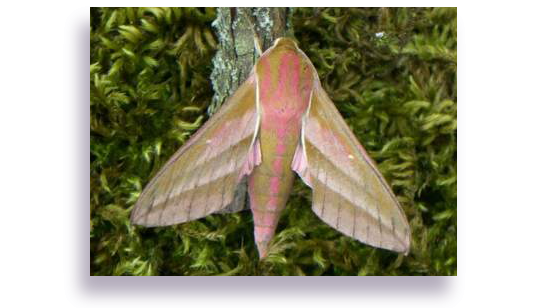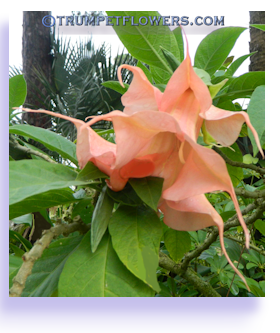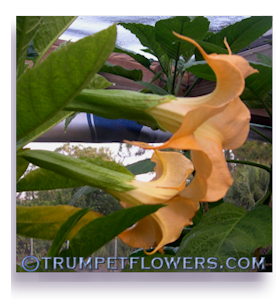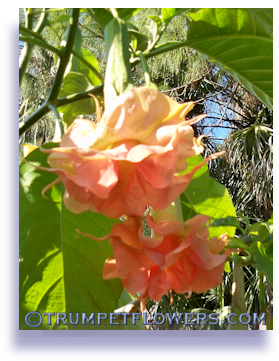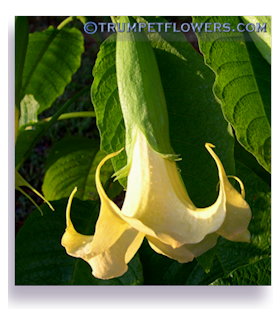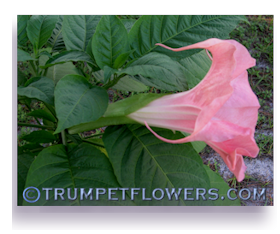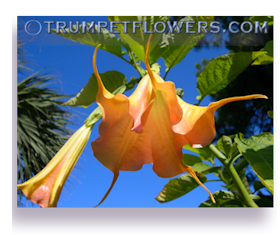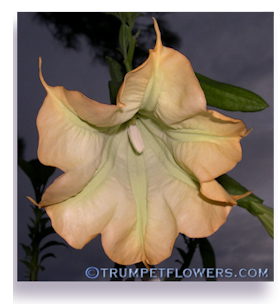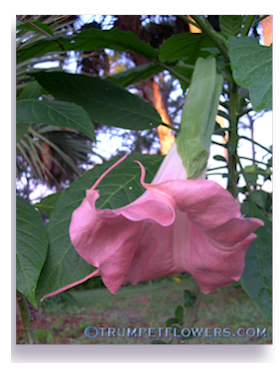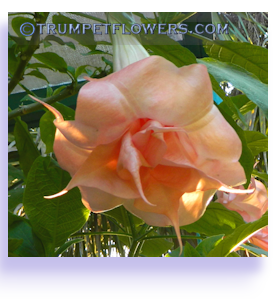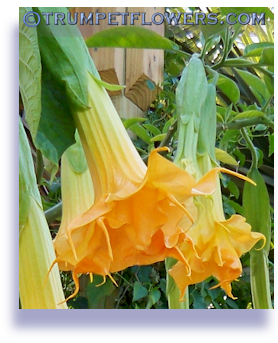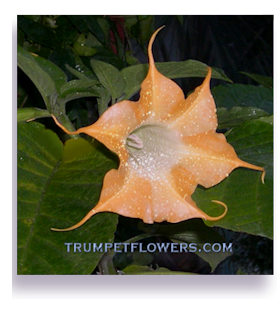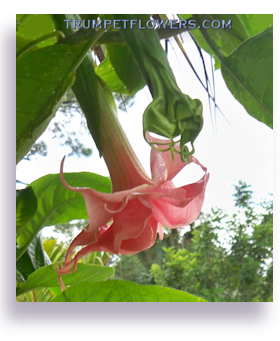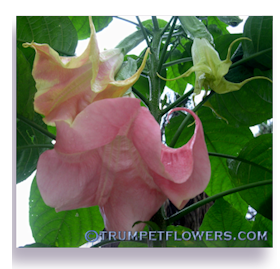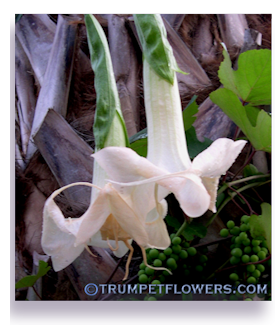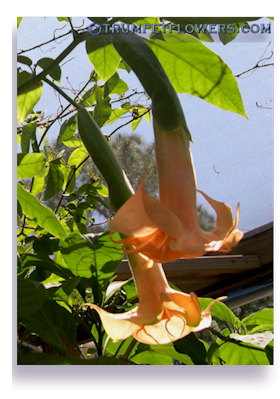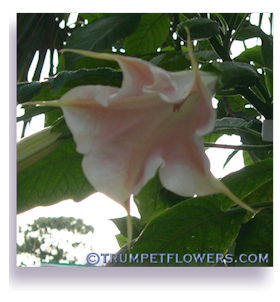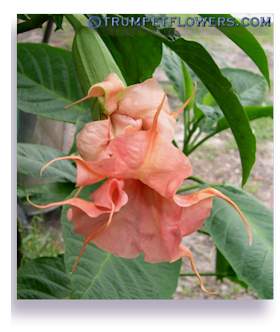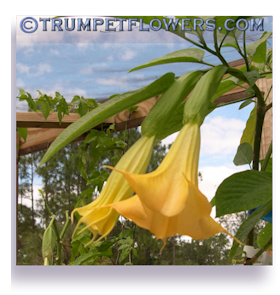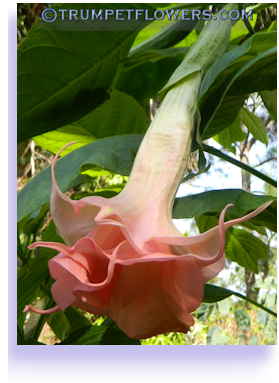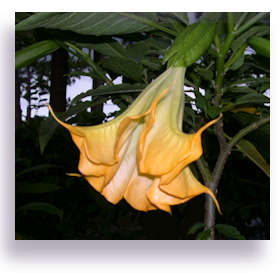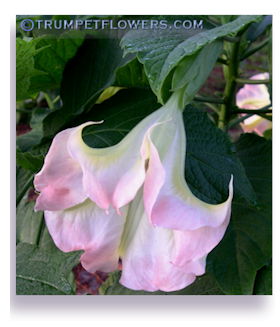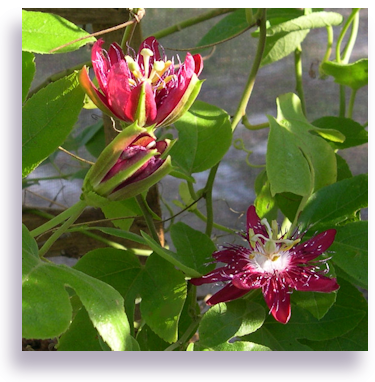 Ask your Angel Trumpet or Other Gardening Questions in the comments section below. Trumpetflowerz will answer them shortly.
Ask your Angel Trumpet or Other Gardening Questions in the comments section below. Trumpetflowerz will answer them shortly.
 Q: What is the best temperature to grow brugmansia in?
Q: What is the best temperature to grow brugmansia in?
A: I see my brugmansia at their best blooming and leaf output performance at temperatures between 60° and 75° F. This does not mean that they don't put on a show in our hot Florida summers! A well fed brugmansia that has ample water, macronutrients and micronutrients, plus fertilizer will flush with many blooms as much as once every 6 weeks to two months, for most of the spring, summer, and fall. Only the very hottest days of the year, usually in August, and the first part of September; do I find my plants holding back and not putting out as many flowers. During these times they still put out a few, just not the large flushes seen most of the other times. In mid∼October and until temperatures drop below 55°,they will begin to put out full flushes again. Brugmansia do not form buds when temperatures are under 55°.
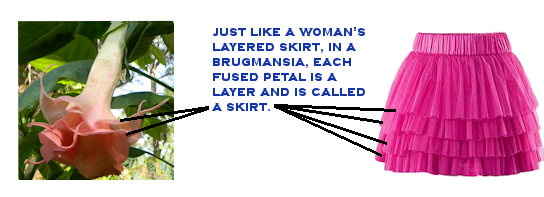
 Q: How long do brugmansia blooms last?
Q: How long do brugmansia blooms last?
A: Brugmansia blooms last longer in the cooler fall temperatures, up to a week. In my zone (10A) I get full flushes of brugmansia blooms on the trees throughout winter, and they easily last a week. In warmer times, like late spring and through the summer, blooms last anywhere between 3 and 4 days. I pinch them off at top of peduncle when the color at the tips of the petals begin to darken. Be careful when pinching, that you do not strip the stem. Cutting them off with scissors is the best way.
Brugmansia blooms will wilt in hot temperatures, but still come back to life the next morning, so do not pinch off wilted blooms that you don't see the actual edge of lip dying.
Here's a list of some brugmansia cultivars I have found to be more heat tolerant than others: Heat Tolerant Brugmansia.
 Q: Is it OK to smell my angel trumpet blooms?
Q: Is it OK to smell my angel trumpet blooms?
A: Yes, it is a beautiful thing to smell! Placing an angel trumpet to your nose is perfectly fine. Angels are onlydangerous if someone were to try and eat (or drink, read the link I supplied) parts of the plant. There is more information about that here. I dive my nose into them whenever I get the chance. Handling them is fine too. It is waaaay overhyped that Angel trumpets are 'poison'. They are actually an halluncinogenic, if plant parts are consumed.
Most of that hype comes from one of the Angel trumpet's close relatives, the Devils's trumpet, or Datura, which is an annual weed that has also been hybridized. It is much more toxic than Brugmansia. However, I am not condoning messing around with Angels. But smelling their blooms up close is perfectly safe.
Note: Brugmansia used to be grouped with Datura, but are now recognized as their own genus. They remain in the Scientific classification Tribe called Datura, but are separate from them in many, many ways. So if you find info on the internet calling brugmansia (the tree) Datura, (the beautiful weed) it is old and outdated information. They are separate species completely.
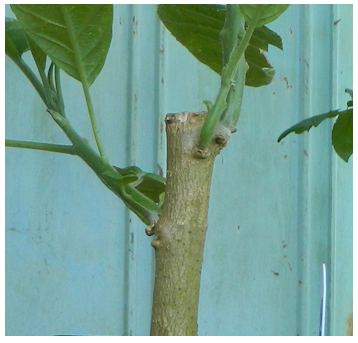
 Q: Is this a Y?
Q: Is this a Y?
A: No, this is not a Y. When the young clone cutting of brugmansia makes more than one branch off of the original cutting,these are simply new branches. This will create a bush shape if allowed to grow. Each of these branches will, of course, Y on their own and flower. This is a Y seen high up in a brugmansia tree.

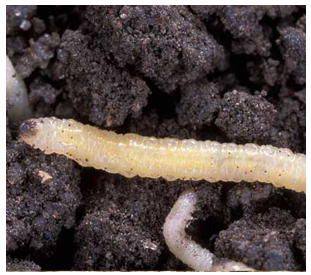 Q: My brugmansia is wilted. I don't understand why, because I water it all the time. What is wrong?
Q: My brugmansia is wilted. I don't understand why, because I water it all the time. What is wrong?
A: This could be several things. Have you recently moved the plant's root system? (From ground or container) If so, the new root system may be trying to re∼root, and will wilt for a few weeks before recovering. Keep it in more shade than normal if this is the case, and do not overwater it.
Myabe you are overwatering your plant. It might be drowning. Slow down on watering a couple of days and see if it perks up.If that doesn't work, there are several other things to consider.
It could be that you have a root worm, a kind of nematode, and/or larval forms of the fungus knat, eating at the inside of your plant. This is a harder issue to solve. If you have not recently repotted the brugmansia, take a few cuttings of it now if possible, and try to get them rooted. 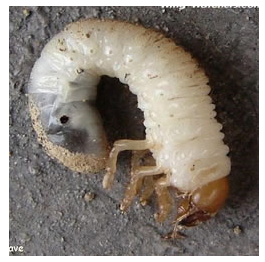 This will give you a backup if the plant dies before you can find the worms. Fungus gnats are usually altogether en masse. Finding the worms is tedious, as you might suppose. Carefully dig the brugmansia up and search for a mushy, hollowed or hole poked root(s). Also take a look at the underground base of the plant for a tunneling entrance into the plant. The worm can be dug out with a pocket knife. If it is found within the base, remove and kill the worm, and apply very warm candle wax to the wound (or pruning sealer) before replanting.
This will give you a backup if the plant dies before you can find the worms. Fungus gnats are usually altogether en masse. Finding the worms is tedious, as you might suppose. Carefully dig the brugmansia up and search for a mushy, hollowed or hole poked root(s). Also take a look at the underground base of the plant for a tunneling entrance into the plant. The worm can be dug out with a pocket knife. If it is found within the base, remove and kill the worm, and apply very warm candle wax to the wound (or pruning sealer) before replanting.
For more information on fungus gnats and their lifecycle, and how to control them, go to the Links page and scroll down to the Gnat link.
Wireworms also attack root systems of plants, and are the larvae of click bugs. For those few who also keep amphibians or small lizards as pets, they are known as mealworms. If mealworms are allowed to complete their life cycle, they become cinch (click) bugs.Larvae can live a long time in the form of worms, from 2 to 6 years in agricultural studies.
Kill adult click bugs whenever you see them. Drive the worms further down into the ground and away from your plant's root system by applying powdered mustard on top of the soil and watering it in. If you are into companion planting, grow mustard around your precious plant to help keep them away.
It could also be the larvae of the Japanese beetle, which is a fat, white grub with a copper colored chitinized head containing pincher∼like jaws. Completely flooding the root area of the plant, whether in ground or in a pot, can cause the grub to surface (it is drowning) and then you can remove it. Flooding can take 20 minutes to bring it up, if this is the problem. Feed the grub to your neighboring bluejays, woodpeckers or robins. They love them.
You can also fight back all of these underground critters with hydrogen peroxide. Here's How to Do It.
The very last thing I would consider as a potential, is Root rot. Learn more about that Here.
 How long does it take a brugmansia to bloom after the appearance of a bloom? (calyx)
How long does it take a brugmansia to bloom after the appearance of a bloom? (calyx)
A: This depends on several things. Temperature, the amount of fertilizer you are giving the angel trumpet, and the actual cultivar of brugmansia. Most of the time, if you are talking about a tiny calyx, that is standing straight up, in the center of a leaf whorl, it takes anywhere from 10 days to 3 weeks to mature into a flower filled calyx to a bursting open flower. Again, temperature, cultivar, and fertilizer will largely play a role in this.
 Q: How tall do brugmansia get to be?
Q: How tall do brugmansia get to be?
Brugmansia cultivars mature at different heights. Some are intentionally hybridyzed to be more compact and small, because some people do not have a lot of room and like them on their lanai or patio, or up close to the house in a bed. These cultivars grow to anywhere between 8 and 10 feet. Some of these shorter cultivars include Peanut, Dalai Lama, Daydreams and Angels Endless Summer. Other brugmansia really grow to nice heights, and look fabulous actually in the landscape, if that is possible. Some of these taller cultivars include Santa Rosa, Sam, Angels Honeymoon, Dorothea, Mango Crush, Naughty Nick, Emerald Frost, Frosty Pink, Jacayna and Ecuador Pink. Their heights range from 12 to 20 feet. Lastly, all brugmansia will continue to grow if you live in zones 10, 11, and 12, if their roots are placed in the ground.
Other cultivars of angel trumpets will stay shorter than their relatives, unless you plant them on top of a compost pit! Some that seem to stay smaller in height are Dalai Lama, Moulin Rouge, Peanut, and Kleine Lady. These seem to top out at around 8 feet maximum.All cultivars can be pruned, if you do it carefully and above the Y, to a height that pleases you.

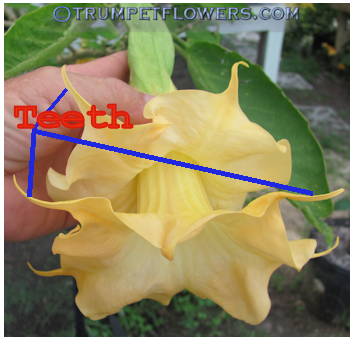 Sport: A sport is a section of the brugmansia, usually an offshoot from the base of the plant, that is different than the mother plant. As an example, a solid colored leaved brugmansia that throws off a shoot with variegated leaves. The variegated offshoot is called a 'Sport.' It can be cut off the mother and registered as such. An example of this would be Frosty Pink, who is the original plant, and gave rise to an offset variegated shoot, which became a separate cultivar known as Emerald Frost.
Sport: A sport is a section of the brugmansia, usually an offshoot from the base of the plant, that is different than the mother plant. As an example, a solid colored leaved brugmansia that throws off a shoot with variegated leaves. The variegated offshoot is called a 'Sport.' It can be cut off the mother and registered as such. An example of this would be Frosty Pink, who is the original plant, and gave rise to an offset variegated shoot, which became a separate cultivar known as Emerald Frost.
Teeth: The term 'Teeth', or 'Tooth' is referring to the long, pointed appendages that appear on the edge of the fused petals of the brugmansia flower. The old saying 'Long in the Tooth' is a very good thing in brugmansia, most breeders of them want nice, long teeth. Most brugmansia have 5 teeth per bloom, but there are exceptions, such as Jacayna, who always throws 6 teeth. Sometimes a brugmansia cultivar who had a parent such as Jacayna, like Dalai Lama, will also throw a bloom or two that has 6 teeth. I like to call them fangs too :)
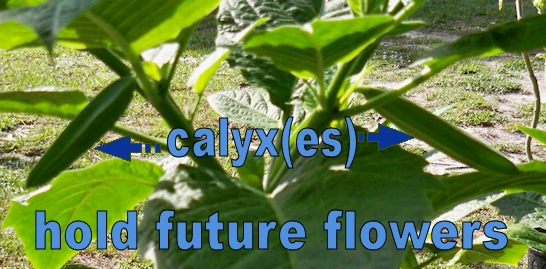
 Q: I have big pods on my brugmansia plant but no flowers. What's up with that? Also: what does the trumpet flowers look like before they bloom?
Q: I have big pods on my brugmansia plant but no flowers. What's up with that? Also: what does the trumpet flowers look like before they bloom?
A: I am going to assume that you have not seen any flowers at all this season, and therefore eliminating the possibility that those big pods are seed pods. If that is so, and you only have one cultivar of angel trumpet, what you are seeing are the calyxes, which will swell and the tiny flower will begin to grow down and fill the calyx. When it has filled the calyx as much as that cultivar does, it will begin to split open at the bottom and there will be the appearance of your flowers! So, you have flowers on the way, just keep your eyes on the growing calyxes, the flowers are soon to follow.
 Q: How do I get dark green leaves on my plants?
Q: How do I get dark green leaves on my plants?
A: There are a few ways to acheive this. One is the addition of Milorganite to the top few inches of soil, added to the compost on top of plant. Another way is to place the plant in deep shade. Of course, this will only work if the plant can live in a shady environment. (A flowering plant like brugmansia needs a certain amount of sunlight each day in order to create flowers.) Another way is by adding the nutrient nitrogen, which a plant must have anyway. But be careful, too much nitrogen is just as bad as not enough. One other thing to remember, if the leaves ae too dark, it can be a sign of a lack of phosphorous!
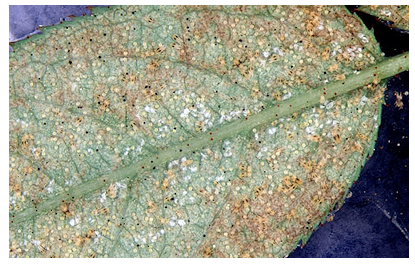
 Q: I have some odd shaped blooms on my brugs (brugmansia). What is wrong? What can I do about this?
Q: I have some odd shaped blooms on my brugs (brugmansia). What is wrong? What can I do about this?
A: Odd shaped blooms (and leaves) on brugmansia can be a few things. Either the plant is not getting the proper fertilizing and micronutrients that it needs, or you could have spidermites. Whiteflies could also be a culprit. Let's start with spidermites. Spidermites and broadmites usually deform the calyxes, as well as the leaves. Do make sure that it is spidermites before using the chemical. 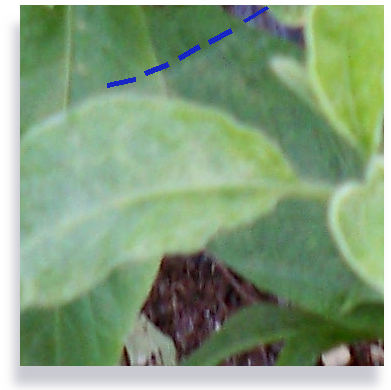 You can check with a magnifying glass, as they are very hard to see. They hang out on the undersides of leaves, and the most tender new growth, including flower buds/calyxes. If it is spidermites, treat them with Forbid,which is available in gallon sizes on the internet for an exorbant cost to the home gardener, or at BGI in a smaller amount, much smaller price, and plenty for many treatments. Apply it as directed. Go ahead and foliar feed by spraying to get more immediate help if lack of nutrients is the problem.
You can check with a magnifying glass, as they are very hard to see. They hang out on the undersides of leaves, and the most tender new growth, including flower buds/calyxes. If it is spidermites, treat them with Forbid,which is available in gallon sizes on the internet for an exorbant cost to the home gardener, or at BGI in a smaller amount, much smaller price, and plenty for many treatments. Apply it as directed. Go ahead and foliar feed by spraying to get more immediate help if lack of nutrients is the problem.
To see some photos that might further help yhou identify exactly what is eating at your brugmansia, visit Brugmansia Leaf problems and solutions. I have some photos ofbroad mite damage, and also aphid, and skipper moth damage.
Now the whiteflies. I already said a few words about them on another page, so read more about them and the treatment for them here: Insect pests and how to eliminate them, whiteflies.

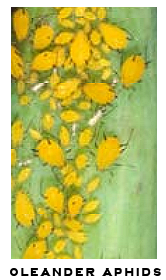 Q: Why are my brugmansia leaves curling?
Q: Why are my brugmansia leaves curling?
A: They can curl from a lack of fertilizer and micronutrients, or an attack by spidermites. Also from a lack of water. Make sure you deeply water the plant in growing season, and have properly fed it. Check for spidermites with a magnifying glass. These pests are minute in size, and hang out under leaves and on tender new growth. Sometimes there are enough of them you can actually see their silk webbing. Use Forbid or a new, organic miticide called Mantis (smells good too!) to fight them.
You can also buy this chemical locally to fight off spidermites: Bayer Insect Disease and Mite Control on Insect Page
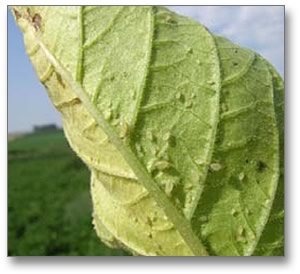 Last but not least, it could also be an eruption of aphids. Where I live, they are usually yellow, very tiny, and can be found underneath the leaves, along the spines, and also on the topside of the very center of the newest leaf and bud growth. Incidentally, aphids can also be white, green or red in coloration, depending upon which species you are dealing with. They are very small, and appear like tiny pinhead sized dots, with see-through bodies. They like to mass together. The Forbid mentioned above will kill them, or if you want to go lighter on the environment, try spraying Neem and be consistent for about two weeks, spraying every morning during that time. The organic miticide called Mantis will also kill aphids.Note:
Last but not least, it could also be an eruption of aphids. Where I live, they are usually yellow, very tiny, and can be found underneath the leaves, along the spines, and also on the topside of the very center of the newest leaf and bud growth. Incidentally, aphids can also be white, green or red in coloration, depending upon which species you are dealing with. They are very small, and appear like tiny pinhead sized dots, with see-through bodies. They like to mass together. The Forbid mentioned above will kill them, or if you want to go lighter on the environment, try spraying Neem and be consistent for about two weeks, spraying every morning during that time. The organic miticide called Mantis will also kill aphids.Note: Brugmansia Growers International Members pool their resources seasonally and purchase Forbid as a large container, then break it down and sell at cost to their members. Kind of like a co∼op. Forbid is expensive on it's own, but joining the Organization gives you the benefit of having access to lower priced allotments of this great spidermite killing treatment.
Brugmansia Growers International Members pool their resources seasonally and purchase Forbid as a large container, then break it down and sell at cost to their members. Kind of like a co∼op. Forbid is expensive on it's own, but joining the Organization gives you the benefit of having access to lower priced allotments of this great spidermite killing treatment.For more on leaf curling and other brugmansia leaf problems and solutions, try this page: Brugmansia Leaf Problems and Solutions
 Q: How old do (angel trumpets) brugmansia trees live to be?
Q: How old do (angel trumpets) brugmansia trees live to be?
A: I have heard reports from friends who see them in their natural homelands of the South American jungles and mountain sides, that they can live well over 20 years, and still going strong. Remember though, that brugmansia sprout shoots from their feet, and these become groves of brugmansia in the wild. So even if your mother plant dies, like many tropical plants, brugmansia continues to live on by reproducing her offspring in this way, as well as by seed. So the mother's genes live on through the root system, even if she does die. But the 20 year age referenced was the original mother.
 Q: How do I get my Brugmansia to make seed pods?
Q: How do I get my Brugmansia to make seed pods?
A: You need two cultivars to get a cross with brugmansia. Here is some very useful information onhow to get started. Crossing Brugmansia I also have a tutorial with photographs to show you this method. Here is the link: Pollinate your Brugmansia. Here's information on brugmansia seedpods in general.
 Q: You told me when I visited and bought my angels trumpet, that I need to pinch the blooms that are getting old. How and where do I do this?
Q: You told me when I visited and bought my angels trumpet, that I need to pinch the blooms that are getting old. How and where do I do this?
A: Blooms on brugmansia can last from 3 days to over a week, depending upon the temperatures outside. In the morning, if you see the lip finally begin to deepen in color, and become flabby and flat, it is time to pinch it off. You do this using a sharp thumbnail or a small set of garden clippers (sterilized in alcohol between plants!).
Where the flower stem, called a peduncle meets the actual branch of the tree, pinch just below, making sure not to damage the branch. Brugmansia have semi∼woody trunks when they are young, and if you pinch too closely to the branch, or do not make a clean cut all the way through the peduncle, you risk peeling some of the bark of the trunk too. This can allow pests and fungus to enter the plant, so be careful. Make sure to throw the spent blooms away, and not leave them lying in the soil of the pot or around the trees on the ground. They draw pests that can cause damage to your brugmansia in the future.
The reason this should be observed in the morning hours, is in extreme heat, the blooms will wilt back in mid-day, but reappear overnight as full and lovely.
 Q: Can I use MiracleGro fertilizer on my brugmansias?
Q: Can I use MiracleGro fertilizer on my brugmansias?
A: Of course. MiracleGro tomato fertilizer is fine. Here's the results of an experiment I did using various fertilizers. Fertilizer Experiment. Use according to directions. Also be aware that fertilizers contain salts of various chemical compositions, and eventually you will end up with a salt build∼up in the container that the brugmansia is in. Flush this out once every 6 months by turning the garden hose on and flooding the pot for 10 minutes or so, allowing all the water to run out of the drainhole at the bottom.Back to the fertilizer. MiracleGro will be fine, and work to give you big bloom flushes every time.
However, as you get more into your gardening experience, you might want to specialize that fertilizer a bit. Read my page on Getting brugmansia to bloom for more detailed information on fertilizers and how to rectify any problems.
 Q: It was time to repot my brugmansia. But when I turned it on it's side and removed it, I saw that the roots were only about a foot from the top of the pot, and had not filled it out all the way down as it should have. What's wrong?
Q: It was time to repot my brugmansia. But when I turned it on it's side and removed it, I saw that the roots were only about a foot from the top of the pot, and had not filled it out all the way down as it should have. What's wrong?
A: One of several things, or all of them. Either you are not deeply watering your plant, and only the surface is being wettened,the pot you used is too large for the plant's original root system, and/or you are not fertilizing the plant properly. The last thing could be that the soil you are using is too heavy. Try repotting in a soilless mix that is lighter and full of coarse material, plus peat, and make sure to water thoroughly a few times a week, being sure that you see the water running out of the bottom of the planter. Add Osmocote to the soil mixture before repotting too. And make sure to fertilize on a regular schedule. This should solve the problem.
The worst thing it could be (imo) is dreaded Root Rot. This is a serious issue that if not addressed, will eventually kill your plant. More on Root Rot Here, and what to do about it..
Read the Comments section below to see more Questions and Answers
And even more questions here: Top Questions asked about Brugmansia
Tags: brugmansia questions and answers, brugmansia questions, gardening Questions and Answers, hawk moths, horn worms, brugmansia pests, brugmansia curled flower buds, brugmansia broken stem, holes in leaves, gardening answers, brugmansia pods, brugmansia calyx, brugmansia pests, spidermites, aphids, whteflies, grubs, fungus gnats, root worms, nematodes,
